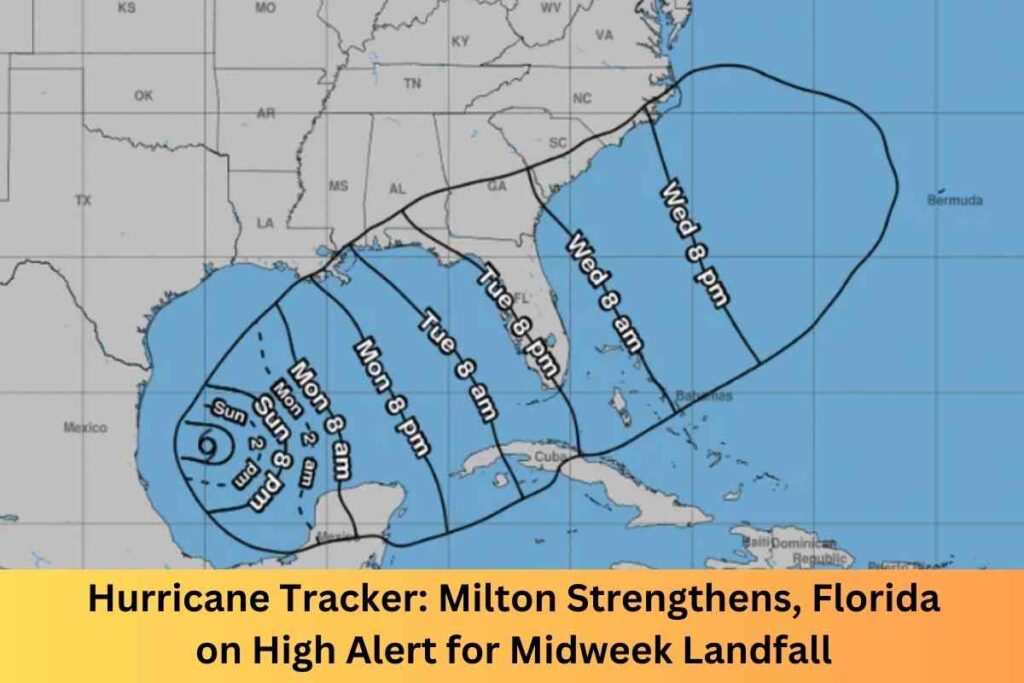Hurricane Tracker: Milton Strengthens, Florida on High Alert for Midweek Landfall :Tropical Storm Milton is rapidly intensifying in the Gulf of Mexico and is expected to reach hurricane strength within the next 24 hours. Florida’s Gulf Coast, already reeling from Hurricane Helene, is bracing for another powerful storm. The National Hurricane Center has issued warnings as Milton could make landfall midweek, potentially as a Category 3 hurricane.
This article provides a comprehensive update on Milton’s projected path, potential impacts, and crucial preparedness tips for Florida residents.
Milton’s Current Status and Forecast
As of Sunday morning, Milton is quickly organizing over the warm waters of the Gulf, benefiting from highly favorable atmospheric conditions. The storm is forecast to strengthen into a hurricane by Monday and could become a Category 3 hurricane by the time it nears Florida’s coast on Wednesday.
According to meteorologists, the storm’s path is expected to target Florida’s west coast, with cities like Tampa, Fort Myers, and Naples in its potential landfall zone. The National Hurricane Center warns that residents along the Gulf Coast should prepare for the possibility of life-threatening storm surges, heavy rainfall, and strong winds.
Areas Most at Risk
Residents from the Florida Keys to Tampa Bay are being urged to stay informed and take precautions. The storm surge threat is of particular concern for low-lying areas along the coast, where seawater could push inland, leading to severe flooding. Forecasts suggest that storm surges could exceed the levels seen during Hurricane Helene.
In addition to storm surge, 5 to 8 inches of rain are expected in central and southwest Florida, with localized areas potentially receiving up to 12 inches. This could result in widespread flooding, particularly in urban areas prone to water accumulation. The storm’s strong winds are projected to extend across the state, potentially reaching as far as Florida’s Atlantic coast.
Preparation and Evacuation Plans
State and local officials are urging Floridians to finalize their hurricane preparedness plans. Residents in high-risk areas should be ready to evacuate if necessary, as Milton’s landfall could bring severe, life-threatening conditions.
Officials recommend that residents stock up on essential supplies, secure their homes, and ensure that their evacuation routes are clear. In particular, areas near Tampa Bay are being closely monitored for potential evacuation orders, depending on how Milton’s path evolves over the next 48 hours.
Experts are also advising residents to prepare for extended power outages. Simple measures, such as filling freezers with ice and securing outdoor objects, can go a long way in minimizing storm-related disruptions.
Comparing Milton to Hurricane Helene
Milton arrives just over a week after Hurricane Helene, which wreaked havoc on Florida’s Big Bend region as a Category 4 storm. While Milton is projected to take a more southern path, the comparisons are inevitable, particularly concerning the potential for catastrophic storm surge and flooding.
Also Read : Can Aaron Rodgers Inspire a Jets Comeback Against the Dominant Vikings?
The concern is that Milton may follow in Helene’s footsteps, bringing similar devastation to coastal communities. The National Hurricane Center has noted that storm surge levels could surpass those of Helene, particularly if Milton strengthens to Category 3 or beyond before making landfall.
Timeline and Key Updates
- Monday, October 7: Milton is expected to strengthen into a hurricane, with sustained winds potentially reaching 74 mph or more.
- Tuesday, October 8: Forecast models predict Milton will further intensify to Category 3, with maximum sustained winds exceeding 111 mph.
- Wednesday, October 9: Milton is projected to make landfall on Florida’s Gulf Coast, with the Tampa Bay area, Fort Myers, and Naples in the potential impact zone.
As Milton approaches, officials will continue to update forecasts and provide guidance on evacuation orders, storm surge levels, and flood risks. Residents are strongly advised to stay tuned to local news and weather alerts to stay informed.
Impact on Florida’s Gulf Coast
The threat posed by Milton is not limited to coastal areas alone. Inland cities such as Orlando and Lakeland could experience significant impacts from heavy rainfall and gusty winds. As with previous hurricanes, there is the potential for widespread power outages and infrastructure damage, particularly in areas where floodwaters rise rapidly.
Authorities in these regions are preparing for the worst-case scenario, with emergency services on high alert. Hospitals, shelters, and first responders are mobilizing resources to ensure that Floridians can access necessary services during and after the storm.
Climate Change and Intensifying Storms
The rapid intensification of storms like Milton has reignited discussions about the impact of climate change on hurricane development. Warmer ocean temperatures and shifting atmospheric patterns have contributed to the increased frequency of powerful storms in the Gulf of Mexico.
Meteorologists are now closely monitoring storm systems for signs of rapid intensification—where a storm can escalate from a tropical depression to a major hurricane in just a matter of days. Milton is a textbook example of this phenomenon, developing from a tropical depression into a Category 3 storm in less than 72 hours.
Conclusion: A Time for Vigilance
With Hurricane Milton set to strengthen and approach Florida’s Gulf Coast, it’s imperative that residents heed all warnings and prepare accordingly. This storm has the potential to cause significant damage across large portions of Florida, and swift action will be necessary to ensure the safety of those in its path.
Stay informed by following updates from the National Hurricane Center and local weather services, and be prepared to evacuate if your area is deemed at risk. The time to act is now, as Milton could bring the second major hurricane to Florida in just over a week, leaving little room for error.

